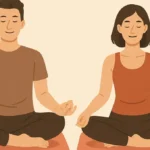
Breakups—whether romantic or friendship—can leave deep emotional scars. In India, where emotional bonds are often strong and relationships play a central role, the pain of separation can be more intense. But there is hope. One powerful way to heal. It lies in yoga.
Why Yoga Helps with Emotional Trauma
Yoga combines movement, breath, and mindfulness. It affects both the body and mind. According to experts, yoga shifts our nervous system from stress mode to calm mode. This lowers stress hormone levels and brings emotional stability. It also strengthens self-awareness and self-esteem, helping individuals feel more confident .
In India, studies from Gleneagles Hospitals in Mumbai highlight how yoga boosts mood regulators like serotonin and dopamine. Regular practice can rewire the brain, making us more resilient.
What Healers Say: Healing Through Yoga Therapy
Yoga therapy blends postures (asanas), breathing exercises (pranayama), and mindfulness. It is used in mental health recovery worldwide. In the U.S., practitioners design special yoga sequences—like twists reaching deeper into emotional pain—or use breathwork to release accumulation of grief . In India, this method is gaining ground too.
A New Yorker report on breakup retreats mentions Kripalu Center in the U.S., where survivors practice grief-liberating postures, guided writing, and meditation for three days . Similar programs exist in India as well. Centers near Delhi and Mumbai offer “healing yoga” retreats that combine asanas, breathwork, and group sharing.
A Step-by-Step Yoga Approach
Here’s a practical yoga sequence for healing emotional wounds:
- Begin with calm breathing (Pranayama).
- Practice deep, slow breaths. Inhale through the nose, pause, and exhale fully.
- This helps calm anxiety and ground emotions.
- Gentle opening postures.
- Child’s Pose, Cat–Cow, or Cobbler’s Pose (Baddha Konasana) open tension in the heart and hips—areas where we often hold stress.
- Heart-opening asanas.
- Poses like Upward-Facing Dog, Camel Pose, or supported back-bends using blocks can release emotional tension from the chest.
- Stay with emotions.
- In gentle holds, allow feelings—sadness, anger, release—to surface. Observe without judging.
- This act of witnessing your feelings builds healing .
- Inversions for perspective.
- Poses that flip you upside down—like Viparita Karani or Sarvangasana—boost blood flow to the brain and shift your mental view .
- Relax deeply in Savasana.
- End with a long final relaxation. Let your body absorb the calm.
- Feel the nourishment of letting go.
- Sit for mindful meditation or Yoga Nidra.
- Close the practice with meditation or a body-scan. This cultivates self-compassion and inner peace.
Real-Life Stories: Healing Through Yoga
Many people who have suffered breakups or toxic friendships share how yoga saved them.
On Reddit, users say yoga offered a non-judgmental space for healing and emotional release:
“I’m much older… yoga was a lifesaver for me. It was a place where I could come and cry…”
“Yoga helped me get out of my head and focus on the now.”
One user found inversions especially helpful:
“Slightly challenging classes… really helped me get out of my head and focus on the now.”
Another shared emotional breakthroughs during Savasana:
“Crying in yoga is a beautiful experience… shedding what no longer serves.”
A user recovering from a toxic relationship added:
“Hot yoga 5× a week… I journal every other day… I did my first solo date last week.”
The Science Behind the Healing
Scientific reviews show yoga helps with depression and trauma symptoms . Studies highlight how mindful awareness, self-compassion, and lowering cortisol work together to ease emotional pain.
Indian news outlets, like The Times of India and IndiaTimes, list five ways yoga aids mental health—stress relief, better sleep, enhanced focus, emotional balance, and immunity support. These benefits are essential when recovering from relationship stress.

Read More: Yoga for Wrist Pain Relief: A Boon for Gamers & Phone Addicts
Yoga and Community Support
Healing through yoga is not just about mat work. In India, mental health support groups and community classes are expanding . These spaces allow sharing stories and finding emotional solidarity after painful separations.
Laughter yoga, founded in Mumbai in 1995, offers another way to heal through joy, breath, and community play.
Tips for Indian Practitioners
- Find a trusted teacher.
Look for trained yoga therapists or instructors who understand trauma and emotional recovery. - Choose the right setting.
Opt for calm, supportive environments—like small group classes or therapy retreats. - Keep it consistent.
Even 30–45 minutes daily is powerful. Experts suggest regular practice for best results . - Pair yoga with other care.
Therapy, journaling, creative activities, and spending time with loved ones all help . - Listen to your body.
Avoid pushing your limits. Emotional wounds need gentle, safe practice.
In Closing
Letting go of heartbreak or toxic friendships is hard. But yoga offers a path forward—one that integrates body, breath, and mind. Through simple postures, mindful breathing, and honest emotion, you can begin a journey of healing.
In India, our yoga legacy gives us a unique edge. We blend ancient wisdom with modern mental health care. Each pause, each breath on the mat, gives you a chance to rebuild trust in yourself.
Yoga doesn’t mean forgetting the pain. It means feeling it, releasing it, and choosing a new path forward. In time, heartbreak becomes a stepping stone toward self-love and fresh growth.
Author: Sonam










